
|   |

|   |
 e-mail: sunilkothari1933@gmail.com Samabhavana: Celebrating New Directions in Indian Dance Photos courtesy: Sapphire Creations March 14, 2018 Sapphire Creations Dance Company, Kolkata, commemorated its 25th year with historic moment in the Indian Arts by organizing a two-day dance conference on 3rd and 4th March at ICCR's Nandalal Gallery under four segments - Provocations, Explorations, Transformations and Negotiations - at Abanindranath Gallery and performances at Satyajit Ray Auditorium. The second day performance Beautiful Thing 2 by Padmini Chettur was held as part of Pickle Factory Season 1 Festival opening performance at Gem Cinema. The sessions were held from 11am back to back in a tight schedule with a large number of participants with a clear agenda to see how New Direction in Indian Dance have moved forward from earlier times. By fortuitous circumstances, I had participated in the historic East West Dance Encounter held in 1984 by Dr. Georg Lechner, Director of Max Muller Bhavan in collaboration with NCPA in Mumbai, followed by another in 1985 titled New Directions in Indian Dance. The other conferences which followed like one organized by Rabindra Bharati University inviting Mrinalini Sarabhai, Kumudini Lakhia, Chandralekha, Manjushri Chaki Sircar in Kolkata in1985, followed by Nava Nritya Samaroha in Delhi in 1989 by Sangeet Natak Akademi and in Toronto, Canada, by Sudha Khandwani and Rasesh Thakkar also titled New Directions in Indian Dance in 1993 and one more in Delhi by Max Mueller Bhavan in 1997 provided the background for the present Samabhavana to celebrate, debate and dissect the yesterday, today and tomorrow of Indian Contemporary Dance. The two major publications of Marg recorded the trends: New Directions in Indian Dance edited by me (2003 and reprinted in 2010) and special issue of Marg Contemporary Dance in India edited by Astad Deboo and Ketu H Katrak in 2017. And yet there is so much that needs to be collated and encountered on one platform. While we are close to nearing 100 years of Indian Contemporary Dance, Sapphire Creations took the initiative to encounter each other once again. The event brought together dancers, choreographers, scholars, critics and researchers on one stage to showcase these new meanderings that dance has taken in India. It was an attempt for a whole new generation of dance-makers and thinkers to have a look into perspective for the future.  Provocation 1 – Sadanand Menon On the opening day under the title Provocation to provide a context, tracing the journey of New Direction in Indian Dance in the last millennium and heading to the future, Sadanand Menon who explores the charged space linking politics and culture through his work in media, pedagogy and the arts, took us all into journey in his illustrated talk 'From Uday Shankar to Contemporary Indisciplinarity in Indian Dance.' It was most relevant as Uday Shankar has been hailed as father of modern dance and with help of clippings from his film Kalpana, Sadanand explained how besides being a vastly gifted dancer, he had through the film Kalpana showed his awareness as a political thinker, tackling contemporary issues of exploitation of labour class by mill owners, education under British rule, social issues of marriage and ills of dowry, rebel against the same, poverty, regaining self-respect, after India became independent, the need for its own independent theatre for dance. Very cleverly using dance, Uday Shankar had by juxtaposing the stories of gods and goddesses, when necessary, compromising to an extent, to make the film interesting and still keeping the issues in focus, worked out various strategies. Poet Gurudev Rabindranath Tagore had asked him to carry on his work in dance and as is recorded Uday Shankar had several shows in Kolkata. He had created awareness, and dance which was looked down upon as a low art, was raised to a high pedestal. Sadanand mentioned that it is important to revive the memories and revisit such historic moments in dance history. Doubtless Uday Shankar was a genius, a visionary and optimist. He showed clippings in which Uday Shankar was archiving the dances of Sri Lanka, Java, and Bali. And why it is important to have archives for terms of references. Why it is necessary to have a strong sense of history. Sadanand also referred to other historic figures like E.Krishna Iyer, Rukmini Devi, their attempts to revive Bharatanatyam. How dance was used as a national agenda to establish national pride, independence and gain our Indian identity. He also drew attention that in order to achieve idealized body, how dance was sanitized by Rukmini Devi with emphasis on spirituality, atma seeking union with paramatma. Uday Shankar through allegory of dance dealt with contemporary issues. The reading of Kalpana in present times is necessary. In India we lack a sense of archiving compared to Germany, where Pina Bausch had kept two storages for film recording of her choreographic works, so if one gets destroyed the other still remains available. Thanks to keeping the dupes of film Kalpana and director Martin Scorsese's interest in keeping the world classic preserved, the film Kalpana has been saved. Sadanand also showed the clips of film Chandralekha which SS Vasan produced after Kalpana was filmed in Gemini Studio and how Kalpana had affected the films in Tamil Nadu. It was important to set the tone in terms of history and also the need for archival material to refresh the memory. The second session as visualized by Vikram Iyengar was Exploration: How are we different yet same! He had mentioned that we are part of a tradition where forms are handed down, where continuity is vitally important. How does one re-engage with the idea of form, re-enter a loaded and already overpowering terrain in search of something that has been lost or something that has not yet been found. One of the central concerns of contemporary art movements in India has always been how to create form to critically comment on form itself. The plurality and diversity of movement expressions in India offer so much variety, but how and why do artists insist on digging their heels to create their own identities within or against the various tapestries of dance and movements we encounter? Krishna Devanandan, a former Bharatanatyam dancer trained at Kalakshetra and had worked for a decade with Chandralekha and later on with Padmini Chettur, currently based in Auroville, teaching Tai Chi and other physical disciplines, asked some six dancers to take the floor. Her contention was how do bodies relate, interact, behave vis-à-vis other bodies. She said that this concept came to her by working with Chandralekha who attempted to explain how to work in a group. Krishna asked each dancer to walk through in one line from one end to another, enter the empty space and move, take seat back and attempt other direction like walking in diagonal, then three in one line closing their eyes and moving. They had also to explain what they felt while walking, their experiences, breathing etc. This exercise took lot of time. Perhaps Krishna could not explain exactly what she wanted to achieve though this exercise. If the bodies have to dance in relation to each other how they have to be conscious about other bodies and not to take things for granted. This exercise appeared to me as one for who actually participated. While watching it, I was not able to grasp what Krishna was aiming at. I was asked to work with Dr. Mitul Sengupta and Ronnie Shambik Ghose who have formed Rhythmosiac and have been experimenting and creating new works based on Kathak and Jazz form. Ronnie has studied Jazz at Hong Kong Academy of Performing arts and Mitul has studied classical Kathak from childhood; besides she is a psychologist creating original movement language out of these two forms. She is a fellow in Kathak from Kalakritti Sanskritti Foundation. Ronnie and she worked with French choreographer and their work Swan Lake Revisited has received international acclaim. Their other works like Buddha –The Why Within and White Lotus Black Sand and recent Eklavya have been well received. Mitul was the first Indian ever to perform in Bejing Dance Festival with her work in July 2014. She demonstrated how she performs traditional Kathak and how she blends with her eclectic sensibilities, the technique of classical Jazz and contemporary Kathak. She explained how Jazz and Kathak are different and what their common points are and how she blends them. Unfortunately, the excerpts of Swan Lake Revisited could not be screened during our conversation. It has been staged at Denmark with Royal Danish Ballet. ICCR in Delhi had arranged to stage it in Delhi and it showed their approach to, as Vikram put it 'contaminate' dance. The hybridity, when blended well, with the two forms gave the experiment another form. Often the autonomy of each form was maintained when performed separately and also the confluence did not jar. I asked about interpretation of mythological stories and various characters, for instance, the story of Aravan, the transgender God, illegitimate son of Ulupi and Arjuna. Mitul said that the work Desolate celebrates the voices of those in the society of mistaken identities, confused gender, unsettled conditions, brutally trapped within and revolves round this confused paradigm of life. The LGBT issues find expressions in such work. Both Ronnie Shambik Ghose and Mitul have been working with their team of young dancers. They are scheduled to go again for a collaborative work abroad. It was important that Rhythmosaic found its representation in this conference. Their work needs to be seen more. Next day we could screen their few works which gave those who had not seen their work, some idea of what they are working on and how they are extending the vocabulary of dance.  Exploration 1 - Vikram Iyengar, Dr. Aishika Chakraborty, Bharat Sharma, Dr. Urmimala Sarkar In the same session which had to be taken on after lunch as the earlier session took long time, Bharat Sharma, Dr. Urmimala Sarkar and Dr. Aishika Chakraborty participated. Son of late Narendra Sharma, Bharat had training in creative dance choreography from his father. He further studied Mayurbhanj Chhau and Kathakali and later on he studied western dance techniques in USA and France. As an arts administrator he worked for six years at Bangalore with India Foundation for Arts. He was a Reader at Sarojini Naidu School of Arts and Communication at Hyderabad and since 2009 he has been Director of Bhoomika Creative Dance Centre in Delhi looking after the institution his father has established. To his credit are choreographic works like Uthaan, Pathik, Kalaasam, Swapnakosh, Jatakmala, Metro Metro to name a few. He has been writing about the history of Bhoomika, and about the years his father spent with Uday Shankar. That would provide valuable history for contemporary dance movement. He recalled two dance festivals of ballets organized by Mohan Khokar for Sangeet Natak Akademi in 1975 and 1976, which were later on discontinued by Government considering them as wasteful expenditure. He spoke about Narendra Sharma and his association with Uday Shankar, how he had to create his own creative work at Almora, how he was encouraged to explore humour in dance, his long work with children at Modern School in Delhi, where he taught for number of years and created outstanding works like Antim Adhyaya, dealing with theme of death; the courses which were planned for training at Uday Shankar Centre for dance at Almora, to inculcating in them, to produce creative works. How idea of curve Narendra Sharma explored transforming body with multiple centres, applying joints of body, improvising different areas, larger spaces, patterns et al. The ballet he created on Committee, inspired from German expressionist choreographer Kurt Joss's Green Table, explored satire. It was important to know this history. How Uday Shankar's associates branched out developing creative dance as a genre needs to be known and referred to. Dr. Urmimala Sarkar was trained by Amala Shankar and V. Raghavan in Uday Shankar style. Later on she developed academic specialization in Anthropology of Dance with special focus on the politics and poetics of gender embodiment. She is also a trained visual anthropologist and has worked extensively with documentation of performance among marginalized communities. Currently, she is Associate Professor of Theatre and Performance Studies at the School of Arts and Aesthetics, JNU, and has several books to her credit. Recent edited book with Dr. Aishika Chakraborty is The Moving Space: Women in Dance. She is also President of World Dance Alliance and is deeply interested in academic studies of contemporary dance. She has done considerable work on Uday Shankar's syllabus in his Almora Centre, studying the newsletter brought out at the centre, and emphasized that Uday Shankar's style was processed by his wife Amala Shankar, as a best teacher. Contemporary is not a given but is moving. She spoke of body changes, body awareness, kinesis, and space moving, every day happenings. She also drew attention how without touching and embracing, Uday Shankar created erotic feeling. She has recently during her tours abroad, documented various important matters at Dartington Hall where Uday Shankar had residencies and also other places which shall serve as valuable material. Dr. Aishika Chakraborty is Director and Associate Professor at the School of Women's Studies at Jadavpur University, Kolkata. She is a grantee of India Foundation for Arts, Bangalore, currently researching history, legacy and politics of gender in contemporary dance movement of Bengal. She received training in dance under Manjushri Chaki Sircar and as a performer-choreographer of Dancers' Guild has performed widely. Her recent choreographic collaborations with the Dancers' Guild, for Chitrangada and Jagnaseni, have received critical acclaim. Her edited book Ranjabati: A Dancer and her World and recent one with Urmimala Sarkar The Moving Space: Women in Dance have been her major contribution. She spoke of her journey at the time Roop Kanwar in 1987 was raped, Shabano's case and coming in contact with Manjushri Chaki Sircar. Manjushri had come as a refugee, lived abroad for 21 years, had studied Indian classical dance forms and when in USA, she had seen works of Alvin Ailey, Merce Cunningham and others and was influenced by Martha Graham. Her thesis was anthropological studies on Manipuri Maibi Women. On her return to Kolkata she started choreographing works which spoke of women's empowerment. She choreographed Tagore's dance dramas with new synergy, creating Navanritya with her daughter Ranjabati. Her works like Tomari Matir Kanya, Chitrangada, and Tasher Desh have been landmarks and speak of contemporary dance movement in Bengal. Aishika drew attention to these two most important contemporary dancers, Manjushri and Ranjabati, whose participation in East West Dance Conference in 1985 in Mumbai drew attention to what was happening in Bengal in terms of contemporary dance movement. 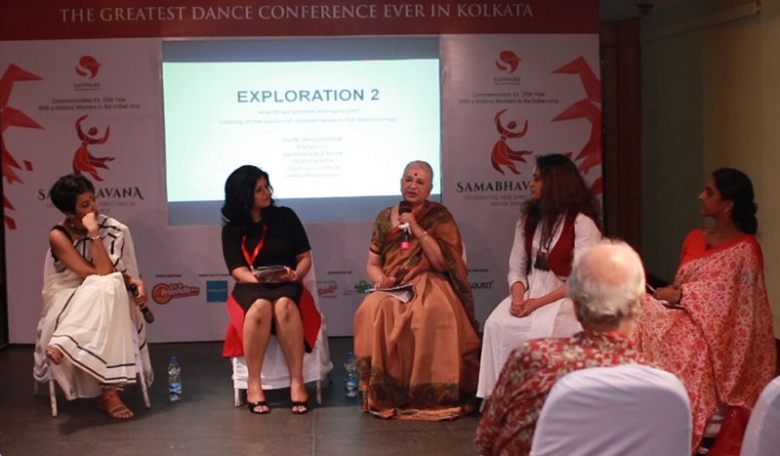 Exploration 2 - Paramita Saha, Vanessa Maria Mirza, Leela Venkataraman, Madhuri Upadhya, Ranjana Dave Exploration 2 guided by Ranjana Dave had the topic: How do we present and represent. The participants were Madhuri Upadhya, Vanessa Maria Mirza, Paramita Saha and Leela Venkataraman. Ranjana Dave in her approach had mentioned about how does market influence dance, how dancers make, articulate and present work. The session was meant to look at the politics of representation in the dance ecology. How does the creative process accommodate the pressures of funding and sustainability? As impresarios how are our curatorial choices a bridge between what artists are making and what arts world wants to see- Indian contemporary dance or Contemporary dance from India? Madhuri Upadhya stated few important matters since she has been actively involved with the musical Mughal-e-Azam as a co-choreographer. She is a choreographer and entrepreneur, at the helm of steering Bangalore based Nritarutya, a contemporary dance company, for last 18 years. She is the force behind Nritarutya's expanding artist development and education wing. A lead dancer in musicals like Madhushala for Amitabh Bachchan, Madhu Milan, Shakuntala and is known for her choreographies for Narendra Modi's Make in India. She has with her relentless pursuit inducted the best talent of our country providing employment to more than 300 dancers by commissioning them for project features. This she considers her most important achievement. She is now involved in building of artists in project Dance N More – a series of specialized workshops with a working balance of the traditional and the modern dance methodologies. She narrated her experience working for musicals. Of the economics involved and also engaging a large number of dancers in such productions, seeing that they are well paid and taken care of. The challenges one has to face and how to meet them with success. She spoke of her experience of working for musicals in Dubai. The stupendous success of Mughal-e-Azam in terms of recent four days shows selling tickets at Rs 25,000 in Ahmedabad and how it has turned into success economically. Vanessa Maria Mirza based in Kolkata was for some of us a new entrant in the field, as a choreographer, dancer whose work we had not seen. She spoke about her background. Trained at Taipei in contemporary dance, she runs her own Dance Bridges Festival, a biennial international dance festival showcasing cutting edge contemporary choreography. She has represented India at Performing Arts Meeting at Yokohama-Japan and American Recon 2017. Her recent choreographic works include Dream Realms, Under Face, Her Song etc. She is keen on broadening the base for contemporary dance. Leela Venkataraman spoke on how dance was like forty years ago when she started writing. She gave an example of Odissi Guru Surendranath Jena who taught at Triveni Kala Sangam and under whom Dr. Kapila Vatsyayan was learning Odissi. His Odissi was different and showed a different facet of Odissi drawing inspiration from Chausath Yogini temple. How to put Odissi under one category? It was not pretty and he maintained not to prettify Odissi. Kumudini Lakhia took poet Sarveshwar Dayal Saxena's contemporary poem The Coat in Hindi for choreography in Kathak. There were many difficulties for categorizing writing on Indian dance. And writing on contemporary Indian dance poses several problems. Paramita Saha, co-director of Sapphire Creations is a performer, contemporary dancer and arts manager. She spoke of Interface, the international Festival of Alternative and Contemporary Expressions, as a co-director of Arts Forward where she designs strategic encounters between businesses and artists to create opportunities for nurturing the creative industries and their contribution to society. Paramita said that she received training in contemporary dance for twenty years and has represented the country in art events and forums across 18 countries garnering valuable experience. She believes that arts can build moving messages for social change for the present generation. She is an ArtThink SouthAsia Fellow and a Global Fellow of International Society of Performing Arts 2018. As an active worker she is one of the leading youth influences in Kolkata and has enjoyed working with 15-30 year age group to inspire them to creative leadership. She was happy that this Samabhavana conference took place for which she along with a team of workers worked hard to mount it. Ranjana Dave as a dance practitioner and arts writer has curated an online archive of dance video at Pad.ma (Public Access Digital Media Archive). As a co-founder of Dance Dialogues, a Mumbai based initiative, she connected local dance community to provocative and adverse ideas, individuals and institutions. Currently she is based in New Delhi and is a programme director at Gati Dance Forum, developing, curating and documenting various projects for the organization. To her credit are two IGNITE festivals of contemporary dance in 2015 and 2016. In recent publication Tilt, Pause and Shift her essay 'Liminal spaces in tradition: Odissi as a continually evolving form' has been included and in latest Marg volume on Contemporary Dance she has discussed significant issues for Contemporary dancers in India. 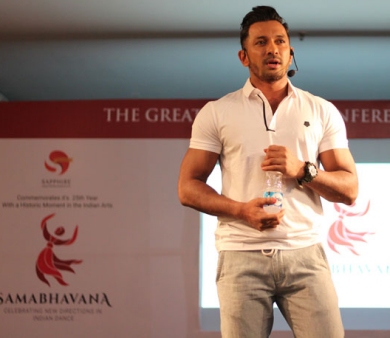 Negotiation1- Terence Lewis In Negotiation1 at 5pm, we were introduced to Terence Lewis, India's leading choreographer, dancer, TV judge and multiple Guinness Book of World Records winner from Mumbai. For many of us this was our first encounter with him, his work and training methodologies and internationally acclaimed dance theatre piece the Kamshet Project. He is a gifted speaker and took us along with him on his journey in dance at a breakneck speed, engaging us in his several adventures to become a dancer, meeting with failures but never giving up. He admitted that he was a brilliant copy cat and never gave up his attempts to work on various planes as a body builder, beauty building project, and his insatiable curiosity finally led him to learning dance systematically thanks to Sussane Linke who sent him to Vienna to study western technique of dance which helped him gain insights into how to build up movement language to the full- fledged Indo-Contemporary dance that is his hallmark today. The Kamshet Project has an unorthodox conception and is a devised rather than choreographed piece. His colleague demonstrated the animal he had selected - Gorilla - and how he behaved and inculcated in the work, giving examples of other animals preferred like dog etc. Terence showed how its unusual genesis has made it particularly hard hitting and relevant, in form as well as themes. One could see how he works on shape-shifting nature of the dance form, as well as the power and relevance of dance. He also mentioned his early career, his job in aviation, packed full five years with comforting income for a young 22 year old man, but all that he chucked up for dance. He was always super sad as he wanted to pursue dance. He went to America, studied with African American dancers, returned to India and formed company with seven to eight boys and worked his way up. He never gave up. Today he is well established, offers international scholarships to bright students, trains others so when few leave him, others substitute them. Mumbai is competitive and when offers come, young dancers leave for lucrative jobs. So he has worked out strategy of paying his company dancers well. His is a success story and he is a part of the contemporary dance scene. One looks forward to seeing his works as and when he is invited to perform in Delhi. Under Proposition in the evening after 6.30pm, five dancers presented their works at Satyajit Ray Auditorium. It was meant to showcase select artists representing iconic and revolutionary movements in Indian dance. The artists were Surjit Nongmeikapam from Manipur who presented TO, a mixed media performance inspired by true stories that the choreographer's grandmother narrated to him when he was a young boy in Manipur. They were caught in the thick of Battle of Imphal. Surjit has given background for the performance in his choreographer's note. He was seen alone on stage with a number of stones all around him. Before the performance began various persons tied the stones with thread around his body. The metaphorical role that the dancer/choreographer performed as a messenger, pulling the weight of the stones on his shoulder was intended to reveal something fragile and beautiful about the human condition. There was also anther story of seven years devastation (1819-1826) when Manipur was annexed to Burma. Weaving these incidents Surjit expressed through dance, carrying the weight of the stones. It was important to know this background to understand and appreciate his choreography. He is a very gifted artist. I first saw his work when Prakriti Foundation presented his work in Delhi. Also Marg issue on Contemporary dance has featured him and introduced his work with visuals. I have been closely associated with Manipur thanks to Guru Bipin Singh and Ratan Thiyam. But I had no clue that there exists this genre of contemporary dance in midst of traditional Manipuri dances. 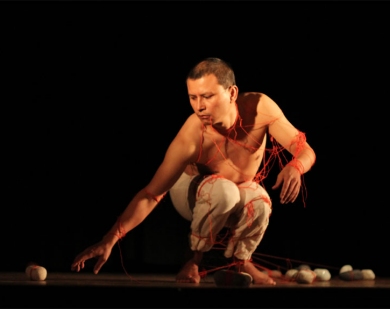 Surjit Nongmeikapam 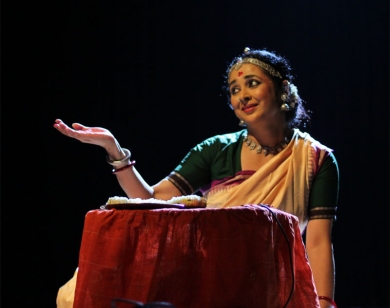 Sharmila Biswas Sharmila Biswas, the versatile Odissi dancer, had presented her work Evoking Radha at Natya Kala Conference in Chennai in December in thematic presentation of shringara. Her attempt to understand 'Radha Bhav' and shringar in classical dance as per her choreographer's note was quite refreshing. Instead of word to word and hastamudra depiction of Gita Govinda ashtapadi, the exploration of the text creates a fantasy world. Sharmila maintains that every woman while living her mundane life longs for such fantasy world. Sitting in one corner, listening to the melodious music of the sung text, Sharmila is seen reading the text which explains Radha's first encounter with Krishna when he has physical union with her. With clever words, Krishna pulling her skirt, (shithilikrita jhaghna dukulam), holding her hair tightly and kissing her (sakachagrah chumbanadanam), were well enacted and then returning to laukik bhava, ordinary movements from Natyadharmi, stylized mode, she succeeded in expressing ordinary woman's desires. Sharmila created sub-text which had several layers. Geeta Chandran revived her work she had created in 2002 titled 'Unurth' to the specially composed music by Shubha Mudgal and Aneesh Pradhan mixed with electric musician V/VM. She attempted to interpret the opposite of beauty as violence, unfair authority, poverty and want, presence of fear and disgust. The peace was produced by Dr. Drew Hemment of Future Sonic. Using the familiar Bharatanatyam adavus, the attempt seemed to strip the physical vocabulary to its skeleton, removing safety net of the anticipated known movements. Geeta has mentioned in her choreographer's note that she has delved into darker corners of her dance. It has stripped off its prettiness. Except for the vocal announcements of 'Give us our rights and fulfill our demands' to which pure dance movements were executed and she had placed her palms to her ears, the rest seemed gelling. But the statement, dance is not a discourse, did not go with experiment. If it is not, then this attempt sounded contradictory. I think the work in context of the conference seemed to me a dance discourse. This work indeed was most unusual from her repertoire. 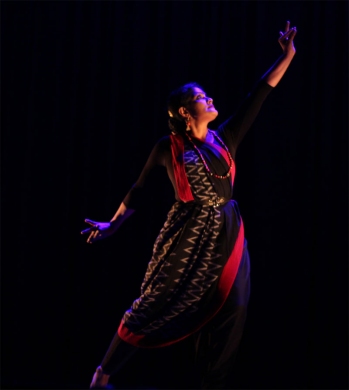 Geeta Chandran 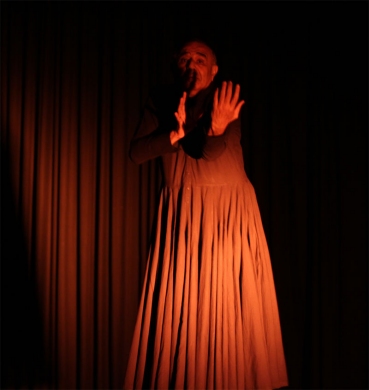 Astad Deboo What can one say for Astad Deboo's excerpt of larger work 'Liminal, below the edge'! He has achieved amazing communication through his dance vocabulary. At 70 plus, Astad astounds one with his energy, ability to balance and with minimal gestures evoke the feelings of disparity, depression, unfairness and anxiety. His upward look, maybe at God, the raised palms, maybe questioning, and the pained expression not registered on face only but also through entire body, like angikabhinaya, conveyed a lot. It was a moving experience to watch this work. And one admired his relentless activities performing all over the world. The finale Yashti by Hemabharathy Palani, trained by Sunanda Devi and Vyjayanthi Kashi in Kuchipudi and in Bharatanatyam by Minal Prabhu, was quite baffling for me as I could not follow the 'single voice echoing multiple truths.' A multi-layered portrait of a woman, through anecdotes by delving into the cultural memories of other women who have chosen an alternative path was not clear. References to the lives of Andal and Akka Mahadevi and their use of images and metaphors of body in their poetry and worship practices, Hemabharathy says, have all fed into Yashti. If so, I was not able to gauge it. It could be my limitation. She is a versatile dancer and performs with great ease. Yashti was selected as a project for The Bench-a funding progarmme set up by 2 Face Dance Company for women choreographers globally. This was produced by Attakkalari Centre. It has toured across UK and is booked for extensive India tour across 2018. 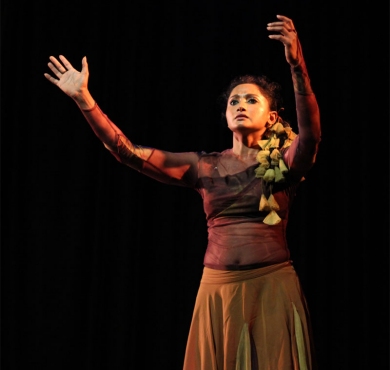 Hemabharathy Palani 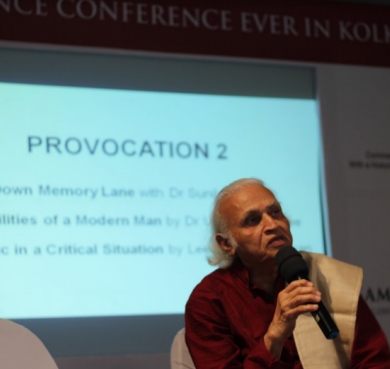 Dr.Sunil Kothari 2nd Day After the heavy, back to back, tight schedule of the first day's proceedings, the morning session on second day was of Provocation. The session of three critics, appeared a little relaxed. LeelaVenkataraman, Dr. Utpal Banerjee and I were to speak on our journey as dance critics. I mentioned when I read Marg special issue on Bharatanatyam in Sept 1957, edited by Dr. Mulk Raj Anand and Mohan Khokar, that led me to meet them and it changed my life. I was pursuing studies of Chartered Accountancy. My heart was not in it. Mulk told me to go and see Mohan Khokar if I can do BA/MA in Dance at MS University, Baroda. He advised me to complete CA and instead of a career as performing artist, explore area of dance writing. Both Mulk and Mohan advised me to attend All India Dance Conference organized by Sangeet Natak Akademi in April 1958 in Delhi. That was another important event which changed my life. I met practically who is who of Indian dance including Rukmini Devi, Balasaraswati, Mrinalini Sarabhai, Dr. V.Raghavan, Lacchu Maharaj, Shambhu Maharaj, young Birju Maharaj, Manipuri gurus, Kathakali gurus, saw for the first time Odissi, Kuchipudi, Yakshagana, Sattriya dances, met Kamala Devi Chattopadhyay, G. Venkatachalam, Dr. Maheswar Neog and several other people who were involved in dance. It was a mind blowing experience watching Balasaraswati singing and dancing, Shambhu Maharaj singing and enacting abhinaya in Kathak. At the end of the seminar and week-long performances, I got an opportunity to go to three states - Manipur, Nagaland and Tripura for conducting research in dance forms of those states. I made up my mind to complete CA and undertake travels within India to research and write on dance forms for Marg. It led me to Odisha, Seraikella, Baripada and my first special issue on Marg on Seraikella Masked Chhau dances, with Mayurbhanj Chhau, researched by Jiwan Pani, was published by Mulk in 1968. It also led me to write reviews in the Times of India as a dance critic. It also brought me in touch with three exceptionally brilliant dancers Mrinalini Sarabhai, Kumudini Lakhia and Chandralekha. They were independently creating new works. Of the three, I was close to Chandralekha. To cut short the story, I had planned to screen Tana Bana video made by Shashi Kumar on Chandralekha in which Chandra has spoken about how she came back to dance after 12 years and during East West Dance Encounter made meaningful intervention. I quoted her few key statements which are valid even today. Chandra's analysis of certain negative features against which she asked us to guard were: Spectacular mindlessness, archaic social values, faked religiosity, idealization leading to mortification of the form, numbing sentimentality, literalism, verbalism, dependence on sahitya, mystification and dollification, perpetuation of anti-women values, quantitativeness , easy assimilation into government designs for propagating a false image of India, cynicism within the solo dance situation and its senseless competitiveness. I was much impressed by her views and when I edited Marg book on New Directions in Indian Dance, I have at length interviewed these three dancers and also Manjushri Chaki Sircar who were creating new works. The video shows Chandra's new works and she also speaks strongly against bureaucracy saying that she exists in spite of them. It was relevant to revisit Chandra's works and her approach to dance. Dr. Utpal Banerjee spoke of his journey reviewing dance, theatre, cinema for past 40 years and mentioned that dancers do not take interest in other arts like painting, music, theatre which could help them a lot. Theatre acts as an agent for change more than dance. He advised dancers to depend less on mythological stories and tackle social issues. He also mentioned that there is need for archiving and suggested various institutions which help dancers to archive their works. In spite of his ill health, his will is dominant and he attended major sessions. 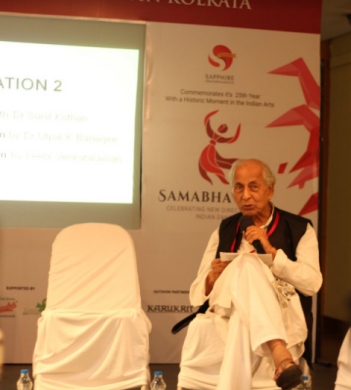 Dr. Utpal Banerjee 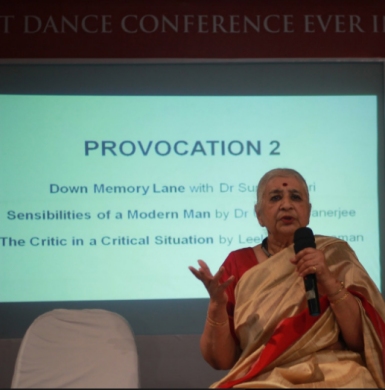 Leela Venkataraman Leela Venkataraman spoke on Dance Criticism at a critical stage. Covering her career as a compere, radio / television interviewer and how she tumbled into writing as a dance critic when Shanta Serbjeet Singh asked her to cover Kathak Mahotsava, she started writing. Since she did not know many people her frank opinion created much stir. She spoke about dances she did not like or follow as in case of Chandralekha, as her own background was different, but when she began to see works of Chandralekha and began to follow, she appreciated her works. She also spoke of 'holy cows' whose works cannot be criticized. And also as in India dancers and critics are close to each other, how it poses problems for criticism. The critical condition at which dance criticism today stands was analyzed by her succinctly. Exploration 3 was conducted by Mandeep Raikhy. He is a contemporary dancer, having worked with Shobana Jeyasingh in London. His choreographic works like Inhabited Geometry and A Male Ant has Straight Antennae have been noteworthy. Currently he is managing director at Gati Dance Forum. He raised several questions: Where does one locate resistance in a performing body? How does the body acquiesce to form and dissent from it? How does it negotiate the boundaries of public and private, personal and performative? Where does one read dissent in performance - is it in the body or in contexts that frame the body? What is the relation between the political and the aesthetic in performance making? Several questions he posed to four participants Surjit Nongmeikapam, Maya Krishna Rao, Daminee Basu and Sudarshan Chakravorty. 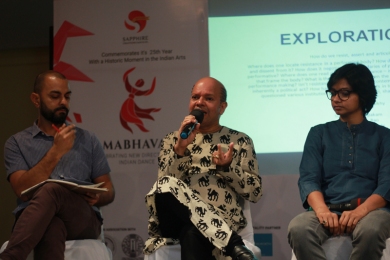 Mandeep Raikhy, Sudarshan Chakravorty, Daminee Basu 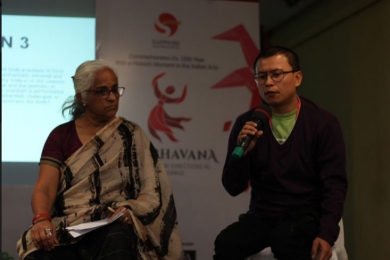 Maya K Rao, Surjit Nongmeikapam Obviously there were too many questions and it was in a way difficult to follow each explorer, who tried their best to answer, in particular, about resistance - the space, the performance, the public arena, the stage, the personal complexes. Maya Krishna Rao was most articulate and explained her dilemmas. Daminee Basu, a young dancer from theatre, gave her background. Her parents were from theatre and from childhood she was in theater and how she hated it, seeking freedom as she wanted to be free. Surjit Nongmeikapam from Imphal, having studied Kathak at Bangalore under Maya Rao, wanted to have his own voice, how he gave it up and sought freedom in his own dance creations. Sudarshan Chakravorty described his confusion, creating dance and not knowing what it was, even when he created 'electric dance' as he called it, and after watching works of Manjushri Chaki Sircar and Narendra Sharma's Antim Adhyaya how he developed courage and held workshops, formed Sapphire Creations. He had choreographed a work Alien Flower based on homosexuality twenty five years ago and had shown courage to work out dynamic experimental form resulting from individual and ensemble mind-body improvisations. In his innovative form he raised sensitive contemporary issues. He has worked for fields of fashion film and television, and has led his troupe across twenty two countries. His recent work Ekonama has won critical acclaim and has been staged in Washington in West America. He nurtures Sapphire as an academy of young ideas. The session could have answered many issues but too many questions posed simultaneously did not help, though it must be said that it was quite an exciting session. 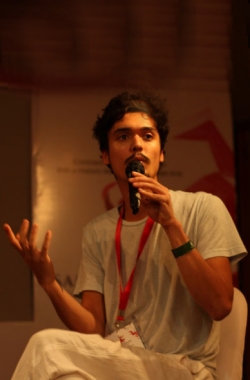 Tao 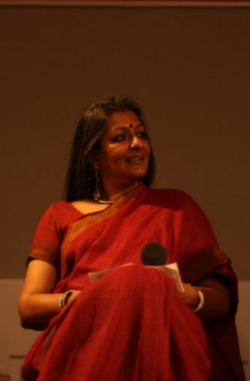 Nandita Palchoudhuri 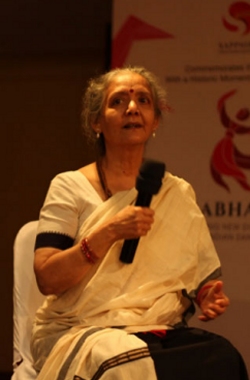 Daksha Sheth Nandita Palchoudhuri, a social entrepreneur, trained in classical music under Girija Devi and curating and consulting internationally in the field of Indian Folk Art Craft and performance practices held conversation with Daksha Sheth and her musician son Tao in session Transformation. The trajectory of Daksha as Kathak dancer, staying in Mathura/Vrindavan, performing in temple, marrying Australian musician Devissaro, who studied Dhrupad, flute and composed music for all works of Daksha has been quite interesting. Trained by Kumudini Lakhia, Daksha studied Kathak under her, was influenced by Kumudini's revolutionary ideas, moved away from Kathak, studied Mayurbhanj Chhau, Kalaripyattu and is settled in a village near Thiruvananthapuram for past twenty years, creating her own choreographic works using mallakhamb and rope technique introducing rope in Indian dance. Her outstanding works have been Bhukam, Sarpagati, Yagna, Sari, and Shiva Shakti. She has created her own genre of works for which her daughter Isha Sarvani, son Tao, husband Devissaro work together. They live in a place where they have built a studio where international artists visit and also work. Their works have been performed in Canada, Australia, Europe, UK and Daksha Sheth Dance Company has won critical acclaim. Tao has blossomed into a fine musician and has acquired a BA degree in music from Perth University. Isha performs along with the company and had stint in Bollywood film and television. Daksha from a Gujarati family from Ahmedabad has led a most unusual life and has charted her own path. The conversation then turned into how artists can work out a way to become economically independent and could there be strategies worked out with corporate sector which without interfering in the artistic activities can provide financial assistance.  Aditi Mangaldas on Skype 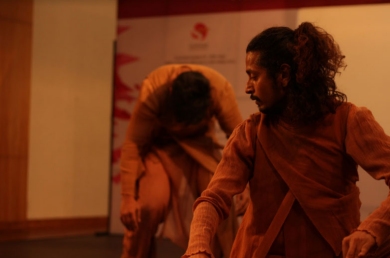 Minaz and Manoj from Aditi Mangaldas's troupe Negotiation 2 was held with help of Skype as Aditi Mangaldas was unable to come on account of ill health. She spoke and also showed excerpts of her works based on classical Kathak dance. She insists that her contemporary works are based on classical Kathak in which she was trained by Kumudini Lakhia and Birju Maharaj. Her range of works is quite extensive and the latest Interr_upted was part shown on screen and was demonstrated by two of her Drishtikon Dance Company male dancers Minaz and Manoj who used also other dance forms and seemed to fuse different energies in Kathak. Aditi has also worked with international lights designer and mentors creating her own niche. Her works have been widely seen in UK, Europe, and Canada and within India. She did reject SNA Award given to her for contemporary dance in Kathak maintaining that her work is based on classical Kathak and she is a Kathak performer. However it hardly matters now. Her contemporary dance is based on Kathak, though of late various other influences can be seen blending well with Kathak. The evening was the inauguration of Pickle Factory, at GEM cinema which is planned as a hub for creative dance. Brainwave of Vikram Iyengar, it is an innovative and bold step using a cinema hall which was caught up in fire and afterwards it was not used at all. Vikram and his supporters have come forward to turn it into an active centre for contemporary dance works and also as festival venue where workshops, discussions, staging of new works can be held. With an infrastructure which can further be developed it seems it will turn into a major centre for creative activities. Facilities for food stalls would help artists to meet there and 'hang out' to have exchange of ideas which would promote creative dance movement in Bengal. 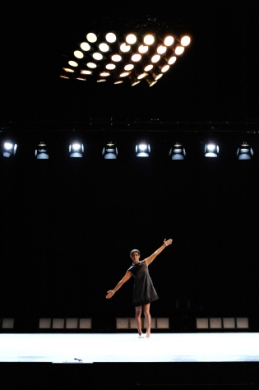 Padmini Chettur in Beautiful Thing 2 Though still seating arrangements are underway with wooden benches and the floor is serrated, the performance space needs to be made workable. Plans are afoot and soon it would be used. The opening event was Padmini Chettur's choreographic work Beautiful Thing 2. Padmini worked with Chandralekha for more than a decade and later on moved away from her to create her own choreographic work independent of Chandralekha. Whereas Chandra's work primarily engaged itself with deconstructing the form of Bharatanatyam, Padmini formed a practice that shifted the choreographic tradition to a minimalistic language. She visually translated philosophical concepts of time and space as they relate to contemporary experience. Her work is highly abstract in nature. During her career spanning two decades, she has collaborated with light artists, film makers, sound artists and sculptors to realize her choreographic works. Her works focus on the form and movement of the body. Her work Beautiful Thing 2, as seen at Pickle Factory's Gem theatre, evoked this feeling of looking at form. She stood in one corner of the theatre near the wall stretching her two arms with clenched fists and started moving slowly in one direction, then moved along horizontal line and soon the physicality of the body became abstracted over time. She walked on the floor like an animal, a walk from Kalaripayattu of a camel, slid on the floor and crossed it diagonally. The work involves nine lines. The taut muscles of her legs and calves showed the inner strength. The transformation of the body and its dissolution was palpable. As it were the body grew in space. The square she created and moved into started looking hypnotic. Such abstraction to the disturbing musical score evoked a strange feeling. The space became more present over time. Her work demands concentration and one marvels at Padmini's grit to explore both time and space. The two day conference and performances were intense. For those involved in actual practice of the dance must have experienced exhilarating feeling and those who watched and reflected upon the discussions and debates evidently in spite of not exactly understating all issues, still felt enriched by this exposition. Hats off to the next generation of dancers after the seniors who paved the way for new directions in Indian dance, showing in which direction and where Indian dance is moving with its multiple vocabularies and varieties. It was a Herculean task. The booklet giving details of participants is a collector's item and would provide a mine of information for future conferences. The Pickle Factory announced its festival featuring Preethi Athreya's works, workshops and Kapila Venu's Koodiyattam performance along with various other staging of performances. The residencies were also announced offering possibilities to work with groups visiting from abroad.  Dr. Sunil Kothari is a dance historian, scholar, author and critic, Padma Shri awardee and fellow, Sangeet Natak Akademi. Dance Critics' Association, New York, has honoured him with Lifetime Achievement award. Post your comments Please provide your name and email id when you use the Anonymous profile in the blog to post a comment. All appropriate comments posted with name & email id in the blog will also be featured in the site. |